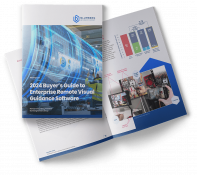Help Lightning Press
How Augmented Reality Can Make Industrial Work More Productive

Augmented Reality today is one of the most coveted technologies as it deploys virtual images over real-world objects. The technology works on computer vision-based recognition algorithms to augment sound, video, graphics and other sensor-based inputs on real-world objects using the camera of users’ devices. In the industrial realm, AR intends to create efficient operations by reducing production downtime, quickly finding out the issues and keeping all the services and processes working.
The development of AR applications has the potential to build robust new industrial solutions. Recently, a Mountain View-based tech company Fieldbit developed an AR application, designed for engineers and field repair specialists, and it places instructions for how to operate machinery and repair malfunctioning industrial equipment directly into one’s field of view.
The technology enables an engineer to see a live feed from a worker’s glass on the ground and place specific instructions into the environment to guide them through a maintenance or repair procedure. With AR, companies even can record the instructions and spatial information into a database for routine processes as well as for future employees that can access the information at any time.
AR for Real-World Industrial Productivity
Integrated with cloud-based services and mobile applications, today’s latest augmented reality technology such as smart glasses can provide workers critical information as they do operations and repairs completely hands-free.
Smart glass technology has grown rapidly since the world was initially entertained by Google Glass and the Glass Explorers. Currently, several vendors are delivering enterprise-class smart glasses with wireless technology, high-definition stereoscopic see-through displays, voice- and gesture-activated controls, HD cameras, and integrated sensors.
Furthermore, augmented reality can transform the way industrial workers perform by connecting remote workers, helping them in intricate tasks, interpreting assembly instructions, increasing worker productivity, and enhancing understanding of business operations.
Connecting Remote Workers
By using AR, firms can get huge advantages in effective collaboration by enabling an expert to see exactly what workers view and then guide them to complete tasks. On the factory floor, technicians can probe machinery or call on a remote expert to fix a production stoppage without waiting for an expert to visit the facility. As a result, enterprises can get benefits in lower operational costs and quality assurance.
Interpreting Assembly Instructions
As technical products encompass tons of components and assembling those factory workers need to keep track of dozens of spreadsheets, AR apps here can assist them by setting up a combined field for visible input, wherein assembly instructions are presented in the same space, using voice control system. With saving time and cost, this will also save potential incidents during the assembling process.
Enhancing Understanding of a Business Operation
In the boardroom of a company, AR technology creates a high-level view of its entire business, presenting exactly what is happening and where. It enables managers and planners to communicate efficiently by using real-time data and analytics that provide updates about the happenings on the shop floor, as a result, it creates better operational decisions across the business.
Source: Analytics Insight












